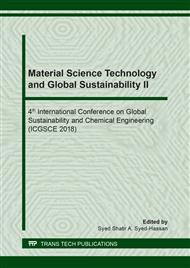[1]
M.A. Abu Bakar, W. Kuntjoro, S. Ahmad, Mechanical and Thermal Properties of LENR Modified Epoxy Composites. J. of Mechanical Engineering. 8 (2011), 77-89.
Google Scholar
[2]
Z. Ahmad, M. P. Ansell, D. Smedley, Effect of nano- and micro-particle additions on moisture absorption in thixotropic room temperature cure epoxy-based adhesives for bonded-in timber connections. International Journal of Adhesion & Adhesives 30 (2010), 448–455.
DOI: 10.1016/j.ijadhadh.2010.04.001
Google Scholar
[3]
N. Anuar, W. R. Wan Daud, K. Roberts, S. K. Kamarudin, S. M. Tasirin, Morphology and Associated Surface Chemistry of L-isoleucine Crystals Modeling under the Influence of L-leucine Additive Molecules. Crystal Growth & Design. 12(2012), 2195-2203.
DOI: 10.1021/cg200266e
Google Scholar
[4]
A. Bandyopadhyay, Molecular modeling of EPON 862-DETDA polymer, Dissertation, Michigan Technological University, (2012).
DOI: 10.37099/mtu.dc.etds/21
Google Scholar
[5]
A. Bandyopadhyay, B. D. Jensen, P. K. Valavala, G. M. Odegard, Atomistic Modeling of Cross-linked Epoxy Polymer. American Institute of Aeronautics and Astronautics. 2010. 1-7.
Google Scholar
[6]
A. Chami Khazraji, S. Robert, Interaction Effects between Cellulose and Water in Nanocrystalline and Amorphous Regions: A Novel Approach Using Molecular Modeling. J. of Nanomaterials. (2013) 1-10.
DOI: 10.1155/2013/409676
Google Scholar
[7]
T. Chang, E. A. Sproat, Y-H. Lai, N. E. Shepard, N. E. Dillard, A Test Method for Accelerated Humidity Conditioning and Estimation of Adhesive Bond Durability. The Journal of Adhesion. 60 (1997), 153-162.
DOI: 10.1080/00218469708014416
Google Scholar
[8]
Z. Jianping, W. Aimin, G. Xuedong, C. Jingwen, C. Song, X. Feng, Molecular Dynamics Simulation of Diffusion of Vitamin C in Water Solution. Chinese Journal of Chemistry. 30 (2012), 115-120.
Google Scholar
[9]
D. Karalekas, J. Cugnoni, J. Botsis, Monitoring of Hygrothermal Ageing Effects in an Epoxy Resin Using FBG Sensor: A methodological study. Composites Science and Technology, 69 (2009), 507-514.
DOI: 10.1016/j.compscitech.2008.11.028
Google Scholar
[10]
H. Liu, Y. Li, W. E. Krause, O. J. Rojas, M. A. Pasquinelli, The Soft-Confined Method for Creating Molecular Models of Amorphous Polymer Surfaces. The Journal of Physical Chemistry B, 116 (2012), 1570-1578.
DOI: 10.1021/jp209024r
Google Scholar
[11]
M. Mieloszyk, W. Ostachowicz, Moisture Contamination Detection in Adhesive Bond Using Embedded FBG Sensors. Mechanical Systems and Signal Processing, 84 (2017) 1-14.
DOI: 10.1016/j.ymssp.2016.07.006
Google Scholar
[12]
Y. Ni, S. Zheng, K. Nie, Morphology and thermal properties of inorganic–organic hybrids involving epoxy resin and polyhedral oligomeric silsesquioxanes, Polymer, 45 (2004) 5557-5568.
DOI: 10.1016/j.polymer.2004.06.008
Google Scholar
[13]
H. M. Shim, J- K. Kim, H-S. Kim, K-K. Koo, Molecular Dynamics Simulation on Nucleation of Ammonium Perchlorate from an Aqueous Solution. Crystal Growth & Design, 14(2014), 5897-5903.
DOI: 10.1021/cg501112a
Google Scholar
[14]
H. Sun, Z. Jin, C. Yang, R. L. C. Akkermans, S. H. Robertson, N. A. Spenley, S. Miller, S. M. Todd, COMPASS II: extended coverage for polymer and drug-like molecule databases. J. of Molecular Modeling, 22 (2016), 1-10.
DOI: 10.1007/s00894-016-2909-0
Google Scholar
[15]
C. Yürüdü, M. J. Jones, J. Ulrich, Modeling of Diffusion for Crystal Growth. Soft Materials, 10(2012), 257-284.
DOI: 10.1080/1539445x.2011.599715
Google Scholar
[16]
J. Zeng, W. Aimin, G. Xuedong, C. Jingwen, C. Song, X. Feng, Molecular Dynamics Simulation of Diffusion of Vitamin C in Water Solution. Chinese Journal of Chemistry. 30 (2012), 115-120.
Google Scholar


